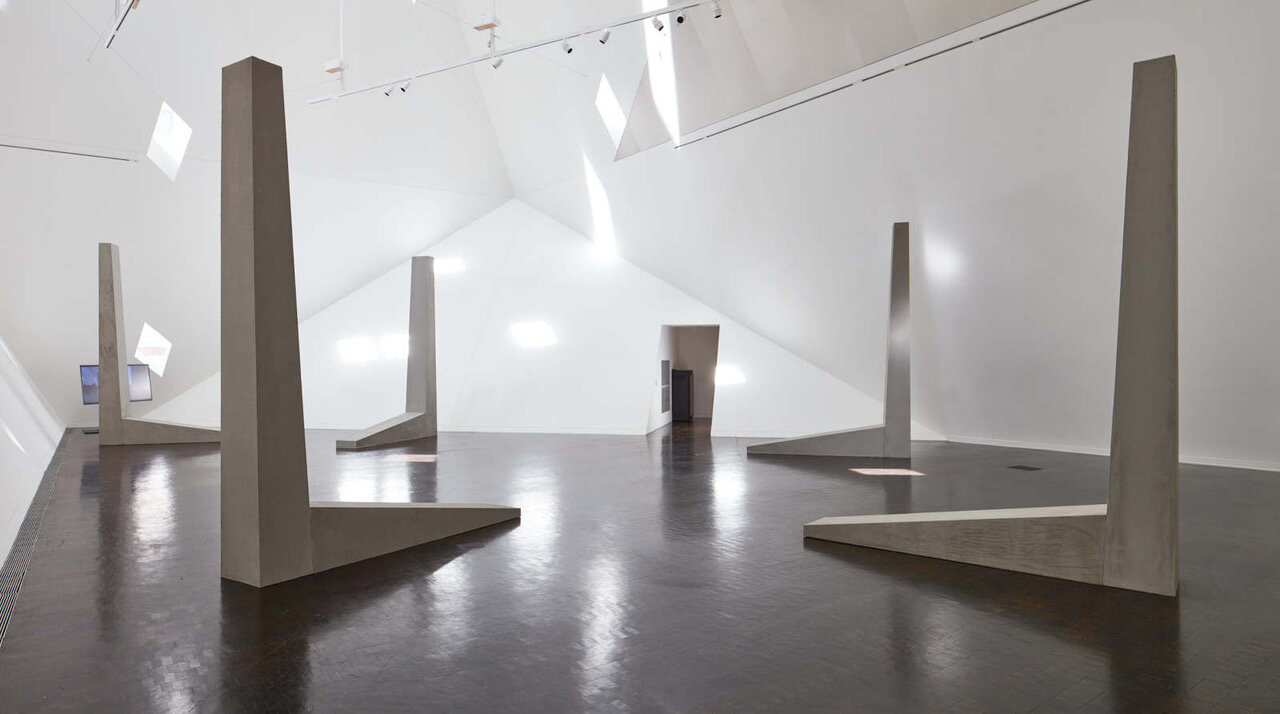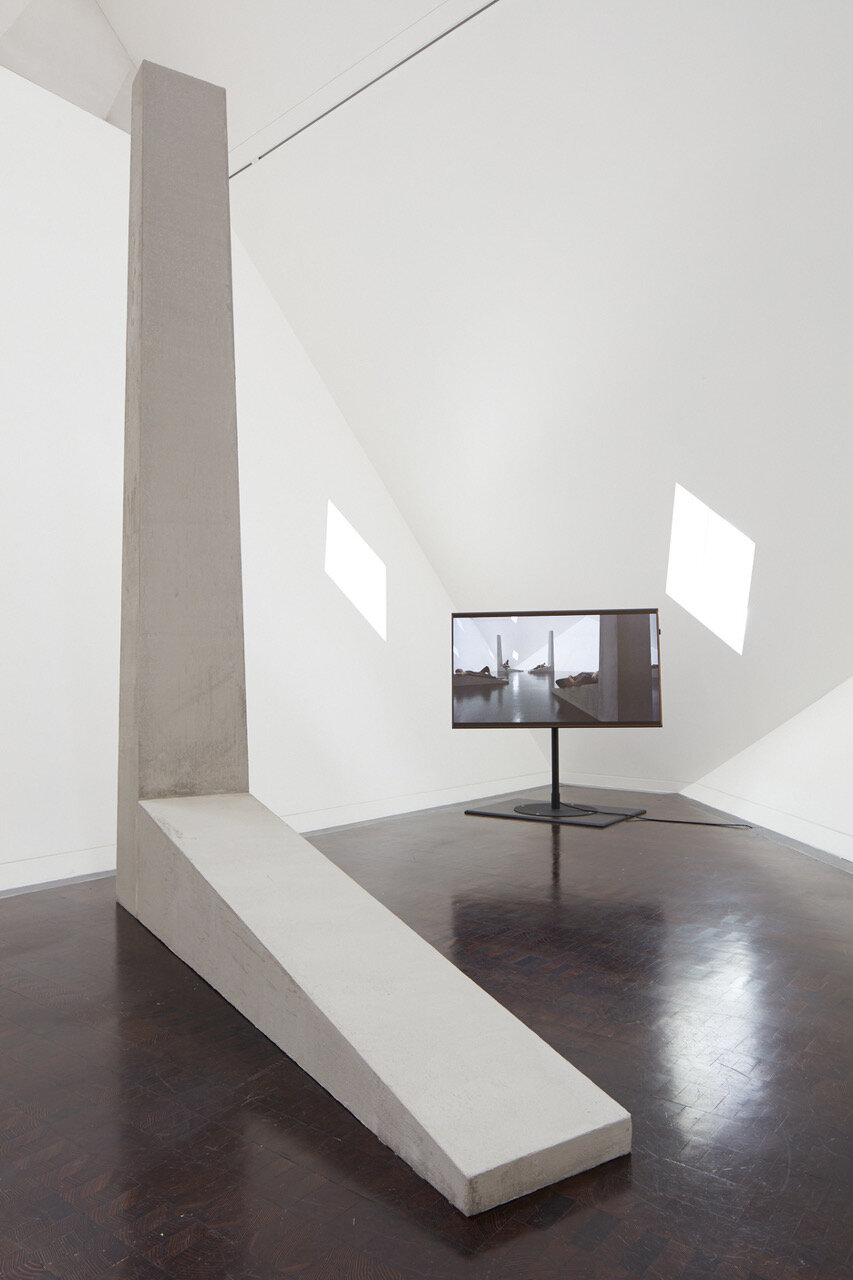Izidora Leber LETHE: Peristyle
July 25 – January 19, 2020
@
Contemporary Jewish Museum
736 Mission Street
San Francisco, CA 94103
In and Around Peristyle
By rel robinson
Peristyle is a body of work by Izidora Leber LETHE curated by Natasha Matteson centered around five monolithic concrete sculptures arranged amidst the asynchronously canted walls of the Contemporary Jewish Museum in San Francisco.
I met LETHE at the museum where we decided to discuss the show off site at the top-floor lounge of the nearby Marriott Hotel. Unable to take the elevator to the fortieth floor before it’s 4:00pm opening, we took the stairs. Each flight was redundantly industrious in material and after a few floors it became impossible to remember where we had started or how much farther was left to go.
As we ascended, I described my interest in her work. LETHE, a US-based Croatian-Swiss artist, was born in the city of Split in the former Yugoslavia and grew up between the two places. My Ashkenazi family moved from what was then Czernotivz in the Bukovina region of Austria-Hungary in time to escape persecution and internment. That place is now called Ukraine and my passport is American, but as an artist living under the Trump Administration much of my research and practice over the last year has probed at the precarious origins and fabricated nature of national identity.
We arrived at the fortieth floor. Reaching for the door, an invisible voice announced we were being watched and warned us to turn around immediately or they would sound the alarm. While traversing forty flights of stairs pales in comparison to the plight of emigration it also felt abstractly illustrative of it. We weren’t allowed to enter but we were allowed to leave and didn’t know where to return to. We roamed, looking for a place to sit and talk but everything was priced for tourists or unsuitably cacophonous and filled with men wearing Patagonia.
Much like San Francisco, the Contemporary Jewish Museum is an amalgamation of historic facade and unanticipated futuristic intervention. The building is composed of a neoclassical power station and a blue steel addendum designed by architect Daniel Liebeskind – the Stephen and Maribelle Leavitt Yud Gallery, where LETHE’s Peristyle holds court. The five concrete sculptures are modeled after Yugoslav Brutalist architecture. Trailing the legacies of post-Minimalism, there is a temporal and gestural quality to the otherwise laconic objects. Concrete is ubiquitous and utilitarian. It’s industrious but painterly with evidence on the surface of being laid by hand. Unlike traditional Classical architecture, this concrete peristyle invites us in. It is made of a populist material, granting us increased agency over our relationship with our surroundings — a means of eliminating our separateness.
The term peristyle can be used to describe both the colonnade that surrounds a courtyard and the space itself. When you enter the installation, you’re both surrounding and contained by it. Without explicit orientation viewers sit, step, and lean against the sculptures without invitation; prompted by the indeterminable purpose of a space unserviced by a prescribed function. This interventionist architecture is unspecified without a clear binary of here and there; place and history are queered. We are left to ascribe our own definition.
The Yud Gallery is pocketed by recessed skylights, which in the late afternoon, project doppelgänger reflections onto its cathedral walls. As one moves through the space, it’s difficult to separate these glimpses of the outside world and their image. This sensation of liminality is perhaps the somatic definition of the diasporic: to be suspended yet situated between here and there. Much like belonging, it’s a feeling that is difficult to locate. As LETHE articulated to me, the refugee flees, the immigrant arrives, and the emigre leaves, However, everyone has somewhere they can’t return to. LETHE’s work cements this immeasurable truth.
On the far end apex of the gallery stands a video monitor featuring the show’s performative accompaniment; single vantage point frames of seven performers attempting to maintain an impossible stillness within the gallery, atop the sculptures, and throughout the museum’s syncretic architecture. The video begins with their monochrome-clad bodies arranged like an ancient pediment sculpture. Seventeen scenes are demarcated with Roman numerals and their bodies stand still like the promise of antiquity’s irrevocability and waver with empty threat of a plaster-cast Doric column facade.
The performers each possess what LETHE describes as an embodied cultural knowledge—each holding a relationship to diaspora through syncretic national identities. In one scene a performer’s eyes are tightly shut, but the camera dwells on their quivering eyelids. Their stillness suggests stoicism but exhales with a sort of relief, eliminating the guise of perennial control that architectural structures are designed to preserve.
LETHE’s place of birth, Split, Croatia is the site of Roman Emperor Diocletian’s palace, a hegemonic nebula turned place of public gathering where the artist spent childhood afternoons. In conversation, LETHE made the distinction between history that is touched and history that is seen. History, in form, is sedimentary. “History mutates; I’m only interested in antiquity because it is still so constitutive of western civilization and its global imprint.”
In my American education, history was taught as an abbreviation of the land that holds it. The story begins with the invention of this place as defined by colonialism, but history is something that is visited. We find it colloquially in the Liberty Bell, the Pyramids of Giza, and in family photos taken at the Parthenon. Considering this in the context of LETHE’s work I wondered, is history a gift or a burden? Who bares the weight of its responsibility?
During our visit LETHE described her interest in provoking how an aesthetic or ideology can be constituted by a place through histories that aren’t transmitted, those that remain immortalized in stone and become immortalized in history because we understand the status quo to be the naturalized state of things.
Faced with this paradigm I considered my home in San Francisco, the major west coast city most concerned with its self-preservation; the image of itself as its greatest form of currency. As someone who grew up in Los Angeles, somewhere that has nothing to do with where it is, San Francisco fills me with a feeling I can only describe as a sense of place. After we said our goodbyes, I headed toward Market street to catch the bus home and passed a hoard of tourists pooled at the foot of Powell where the trollies turn around; patiently waiting to experience the place they were promised.
Photo Credit: JKA Photography



